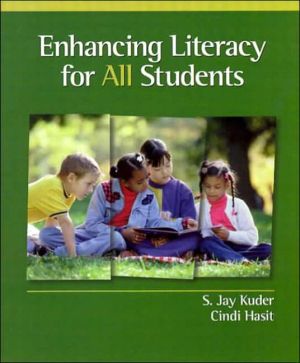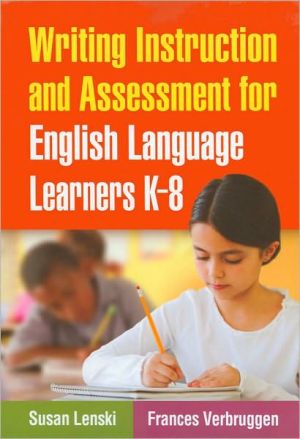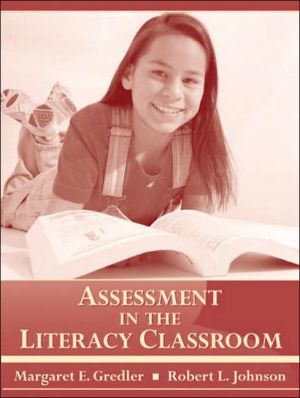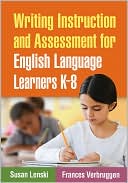Enhancing Literacy for All Students
This book prepares teachers to shape the reading, writing and language skills of children in diverse classroom settings. With its focus on early literacy activities in home and school settings, this book offers thorough coverage that helps readers grasp literacy development as it occurs from emergent to advanced levels. Rooted in practicality, it presents methods that have been successful with children who have a wide spectrum of learning abilities as well as those with substantial learning...
Search in google:
This book prepares teachers to shape the reading, writing and language skills of children in diverse classroom settings. With its focus on early literacy activities in home and school settings, this book offers thorough coverage that helps readers grasp literacy development as it occurs from emergent to advanced levels. Rooted in practicality, it presents methods that have been successful with children who have a wide spectrum of learning abilities as well as those with substantial learning challenges. Chapter topics include foundations of literacy; students with literacy difficulties; assessing literacy; enhancing emergent literacy, early literacy, transitional literacy, and advanced literacy skills; specialized approaches for literacy difficulties; enhancing literacy with students with moderate and severe disabilities; literacy and diversity; and families and literacy. For elementary school teachers of reading and language arts.
Literacy—the development of skills in language, reading, and writing—is essential for success in school and in life after school. Therefore, it is critically important that all children acquire essential literacy skills. For this to occur, teachers and other education professionals must be aware of the latest developments in research on literacy. More importantly, they must be able to translate this research into useful instructional activities. It is our hope that this book will enable teachers and other educational professionals to do just that. EMERGENT LITERACY AND DIVERSITY\ Two contemporary developments in the field of education prompted us to develop this book. One is the new perspectives offered by the emergent literacy model as a way to understand literacy development. The emergent literacy model recognizes the interrelationship of language, reading, and writing skills; the essential contribution of the home environment to the development of literacy skills; and the acceptance of a child's skills as the place to begin instruction rather than waiting for the development of prerequisite skills.\ The second development is the movement toward diversity in the classroom. By diversity we mean not only racial and ethnic diversity but also the inclusion of children with diverse learning abilities as well as children who speak English as their second language. Many of these children experience significant difficulty acquiring literacy skills. In the past, such children may have been placed in specialized programs for children with special needs or in bilingual or English as a Second Language class. Today, most children with literacy difficulties, includingsome children with significant learning problems, are being educated in regular education classrooms. However, it has been our experience that few teachers feel adequately prepared to teach children with literacy difficulties in regular education classrooms.\ We see these two developments, the emergent literacy model and classroom diversity, as complementary. The emergent literacy model suggests that literacy instruction begins at the point where the child is developmentally. There is no need to wait for the development of prerequisite skills. This model suggests that it is possible for children with diverse learning and language skills to participate together in classroom literacy activities. Each child will benefit from participating, but in different ways. TEXT ORGANIZATION AND SPECIAL FEATURES\ We have designed this text to be a comprehensive treatment of literacy development across the age and ability range. Content spans the developmental sequence from early childhood through high school. Throughout this book there is special emphasis on the modification of instruction so that children with special needs can participate in literacy activities in regular education classrooms. In addition, there are chapters devoted to the specialized techniques that may be required for children with significant literacy development difficulties and for children with severe disabilities. This latter population, though often served by special education professionals, is increasingly found in regular education classrooms.\ We recognize that technology is becoming an increasingly important part of the instructional techniques used in schools. Therefore, we have included computer-based and web-based methods and materials throughout the text. In addition, each chapter contains a brief listing of websites that can be accessed for additional information.\ Each chapter begins with a graphic organizer that presents an overview of the chapter content and ends with a set of questions that we call "linkages." These questions have been designed to help readers reflect on the chapter content and extend their learning rather than just recapitulate chapter content. Most chapters include case studies and/or classroom examples that we hope will facilitate the application of research to the classroom.\ We hope you will find this text to be both informative and useful. Our goal is to help you become a better-informed and more-effective education professional, ready to work with children with diverse skills and to collaborate with your peers.
1. Foundations of Literacy. 2. Literacy Difficulties. 3. Assessment. 4. Enhancing Emergent Literacy. 5. Developing Literacy. 6. Transitional Literacy. 7. Advanced Literacy Skills. 8. Specialized Approaches for Literacy Difficulties. 9. Enhancing Literacy with Students with Moderate and Severe Disabilities. 10. Literacy and Diversity. 11. Working with Families to Enhance Literacy Skills.





